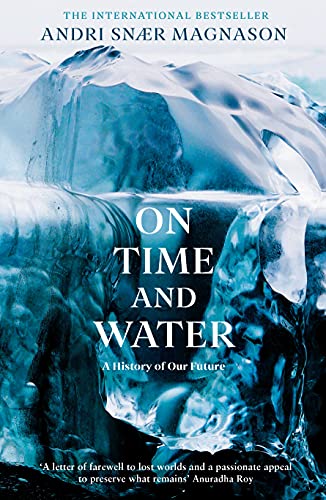
On Time and Water

‘One important thing I am always telling people: materiality is insatiable; there’s no contentment, just more, more, more. Mental development, mental health, nourishing yourself: that, you can develop indefinitely.’
Andri Snær Magnason • On Time and Water
At the beginning of the Industrial Revolution, the ratio was about 280 parts per million (ppm). By 1958, industrialisation had caused a significant increase, to 315 ppm, higher than the highest levels measured on Earth for hundreds of thousands of years. Now we have reached 415 ppm, adding about 2–3 ppm a year. The warming of recent years and
... See moreAndri Snær Magnason • On Time and Water
sculpture she had created in the village of Hveragerdi. It is a stone by a river, with a carved seat, where you can sit and watch the river pass by. The art piece is called It will pass by and it is dedicated to young people with mental problems and suicidal thoughts. Whatever you are dealing with, and however painful it seems, eventually it will
... See moreAndri Snær Magnason • On Time and Water
If anyone thinks changing our sources of energy will be a simple matter, one that will go unopposed, they have another think coming. Oil underpins entire economies; the effects of energy shifts will be immense for those relying on this sector for profit and gain. That $6 billion a day won’t be surrendered casually, not without a struggle. Millions
... See moreAndri Snær Magnason • On Time and Water
Mahatma Gandhi’s words: ‘Earth provide enough to satisfy every man’s needs, but not every man’s greed.’
Andri Snær Magnason • On Time and Water
One ton of oil turns into 2.3 tons of CO2 . Forty-two gallons of oil thus amounts to 350 kilogrammes of CO2 .
Andri Snær Magnason • On Time and Water
But the price isn’t accurate: I pay the cost of pumping the oil out of the ground and I pay the company’s profits, but I do not pay for the consequences of putting all this CO2 into the atmosphere or for the 400,000 square kilometres of land that could sink under water this century. Someone has to pay to remove all this CO2 , either by planting
... See moreAndri Snær Magnason • On Time and Water
If we look at which sectors these emissions come from, 25 per cent comes from coal power plants, central heating and electricity generation. Then 24 per cent is due to food production, logging and land use; 21 per cent is from industry. Transport as a whole is huge, accounting for about 14 per cent of total emissions; there are around a billion
... See moreAndri Snær Magnason • On Time and Water
In October 2018, the world’s oil production exceeded 100 million barrels a day for the first time – the exact same week the United Nations Special Report on Global Warming of 1.5 °C gave a stark warning to mankind about the disastrous consequences of a two-degree rise in global temperature and the importance of not exceeding 1.5 degrees
... See more